THE RAAM CHRONICLES
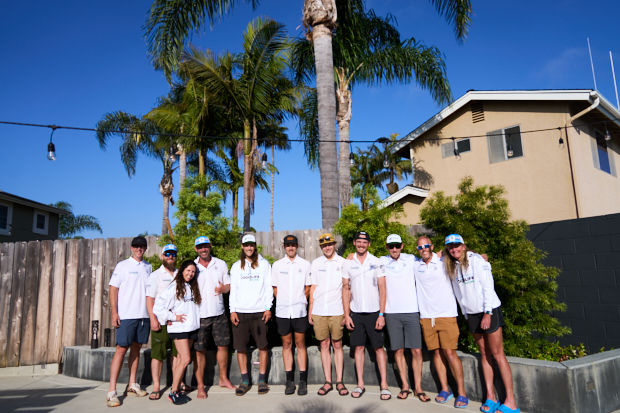
How does this all work in the first place? 4-person team and nine crew members go on bikes 3,000 miles across the country. The original plan for athletes was the popular 8,4,4,8 ratio. The four-person team was divided into two groups, and each group would take their turns within their eight and 4-hour “on” time blocks. The great thing about the 8,4,4,8 is that it perfectly adds up to 24. This means if you start in Oceanside on EST and stay on EST, the riders and crew get to settle into what is and should be a structured time rhythm. The time blocks were set as follows. Crew members were divided into pairs that were also designed to float; 9 crew members, one was always floating around.
Group A: 11am-3pm
Group B: 3pm-7pm
Group A: 7pm-3am
Group B: 3am-11am
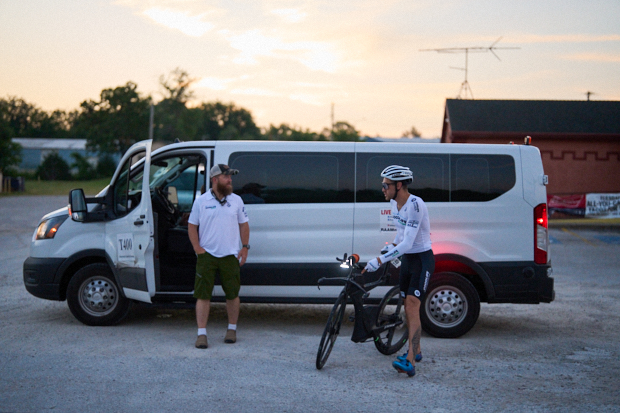
Group A are already night owls, so they took the 11-3 pm and 7-3 am ride times. While Group B took the 3 am-11 am and 3 pm-7 pm shifts. This allowed for 8 hours on,4 hours off, 4 hours on, and then 8 hours off. Because RVs aren’t allowed to be the following vehicle, we set up the following vehicle (Ford 350 low-height transit cargo van) to be the following vehicle, and we chose to make it the “Home away from Home” during the team's “on” time slots. The riders decided to have their bikes inside the van instead of outside on racks. This was so they could keep bikes out of the weather and allow the mechanics to work on a bike during the nighttime when the “Direct Follow” was in place from 7 pm-7 am. I wouldn’t say I liked this idea because I wouldn’t say I liked the lack of space it gave the riders for proper rest, but in the end, the riders had to be in the back of the van, not me.
The rules allow for “one follow vehicle” that can swap out when approved. This meant that every time the GROUPs switched, they needed to swap out most everything in the following vehicle. Which meant our shuttle van needed to be present for that. It was filled with the new riders and all their gear. During the day, that was easy because you were allowed to leapfrog (most of the time), which meant the following vehicle could let the rider go and then catch up. So, the shuttle van would show up to the switch-off spot, get the rider out, and have them ready to tag team the rider coming in. Once the tag had happened, the whole crew would swap out stuff, and the new riders and crew were in the following vehicle and the old riders where in the shuttle van and off to the RV and/or Hotel for some rest.
I will note that the first 24 hours were always a little off, as we needed to shorten or lengthen some of the pulls to compensate for the lack of perfect “8,4,4,8” time blocks. The riders had a plan, and I assumed they would figure it out by communicating with us.
Our firsthand-off was a complete cluster. To start, when the riders downloaded and converted the course map of the RAAM website, it was NOT right. So, the riders were all over the place, and the following vehicle was doing the same, trying to figure out where to go.
Terry from the crew dove in and started radioing the riders' turn-by-turn directions, squaring them away. But the score was now.
RAAM = 1
Slowtwitch GoodLife Racing = 0
The first couple of hours = Jesus Hold the Wheel.
The riders were flying, the crew was catching up in the RV, and the first-time check to Borrego Springs was coming in HOT.
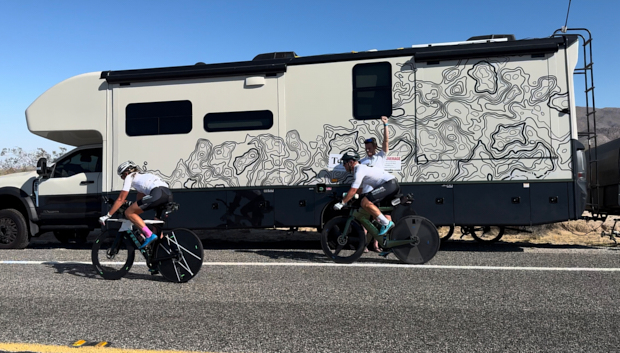
This was our first TEAM blowup and our first and only penalty. We had all stopped (4 cars on the side of the road), we needed to get the first switch done, and we needed to gather our collective thoughts. The tailwinds were 30-40MPH, and it was 113 degrees. Some cars parked about 3 feet from the pavement instead of the required 5. As the official came up to tell me, “I'm giving you an official penalty.” (I don’t know; I get it, but I sort of thought of some of the lame Ironman penalties that have been called over the last year.)
Me, to the official: Can’t you see the huge shoulder the riders have, not to mention the huge ditch we are all trying not to get stuck in?
Official: The real issue is that you have all been here for about 20 minutes.
Me: Did you see the heated argument that caused that delay?
Official: Son, I have seen better; try to make it a real fight if you want to get out of a penalty.
Me: That might happen. Thank you for your time, sir. We will do better.
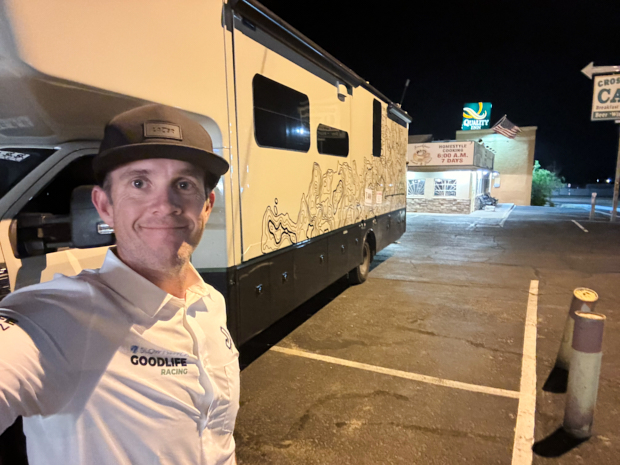
We then had 8 hours to figure out where we wanted to grab a hotel so that the B group could get some sleep and shower. Before the A group stopped, the B group did their first “8-hour shift”. We found a hotel only two blocks from the course route and three blocks from a gas station in Parker, CO. We had the RV set up, and the food was ready. But we chose to have the riders come to us and take a minute to do the swap—the nighttime swaps would also be a little longer. I decided to take an extra 5-10 Mins once every 24 hours to ensure that everyone had what they needed.
We needed to check in, gather our thoughts, and talk face-to-face with each other. Someone didn’t like this idea and let us all know it. So, we got the riders on the road and let everyone know when we were leaving. They had about 4 hours to get a shower and get some sleep. At that point, they could either get in the RV or the Shuttle Van and get some more sleep while we were moving toward the other riders for the swap. We were on the first night of RAAM, and our first day was behind us.
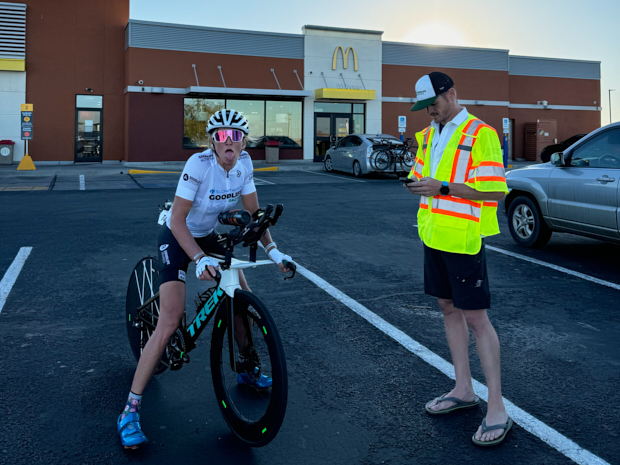
Day 2 was hot, leading us towards Flagstaff. Passed Flagstaff riders saw 115 Degrees during their time in TUBA CITY. Thanks to the tailwinds, riders were also still getting STRAVA RECORDS.
During that time, the riders continued to fly, and the crew continued to play catch up. The generator in the RV wasn’t working perfectly, so we couldn’t make meals, and we were forced to rely heavily on the RV’s front AC unit instead of the two substantial overhead units. It was working, but not really (did I tell you the fridge broke the day we arrived in Oceanside). We had just picked up our last crew member “Spoon” in Flagstaff, and the first thing he did was get the generator working again (sort of), but because of this CLUSTER F@#$ going on in the background, we were still making game-day decisions that needed to be made. For example, Group B at 7:40 pm stopped at McDonald’s, which took about 10 mins. We were about an hour past our allotted 4-hour “Pull Time,” and the athletes needed REAL food. It was past 7 pm, so the follow vehicle wasn’t allowed to play leapfrog, so that meant we all needed to stop. So, I assumed 10 minutes was better than an hour-long penalty. The other reason for the stop was we were in a complete DEAD zone. Our phones didn’t work, and our radios also had ZERO LTE service; we were getting ready to enter the deep parts of the Navajo Nation, one of the most scenic sites I have seen. It’s also the most nerve-racking place to be at night; the fewer stops after dark, the better. During the pass-off, the tension was high for some, and others enjoyed the sunset with a Big Mac.
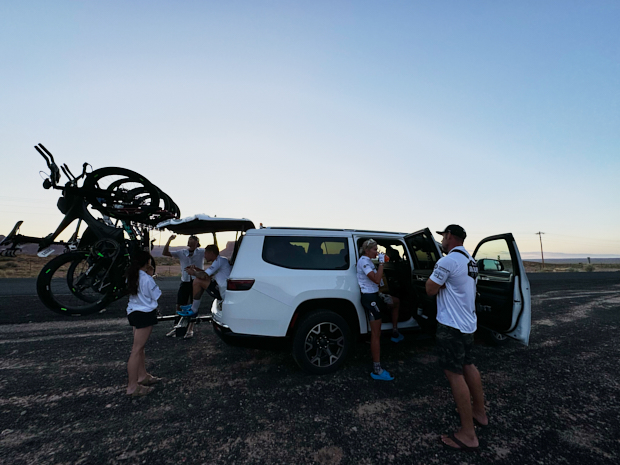
Group A took off at about 8:30 p.m. into the sunset of the amazing desert, and we, the crew, had some work to do. By this time, riders were starting to hurt. The heat and stress had started to really get to them. I had been throwing up from dehydration, and the RV was lost.
We found the RV an hour later and went to the next stop. (Durango) We took the shorter route to get some time savings with the hope that we could get the riders to the hotel faster, and then we could get some of the crew some extra sleep. At about 2 am, I get a call on the radio that the riders are freezing and don’t have anything warm… WTF, I thought… So, I do the old Jason West slap myself in the face, grab the stuff they didn’t have packed, and start heading towards the mountain peaks 50 minutes drive away. Pass off the warm weather gear and head back to the hotel. Our chef was passed out in his hotel room by this time, and the other riders were dressed in warm-weather gear. At about 5 am, the cold riders arrived at the parking lot, beaten down and hungry. We didn’t have a hot meal for them from the RV because we had a Denny’s down the street, and the hotel was serving breakfast in about 30 minutes. (Oh, and our generator wasn’t working again).
Apparently, that was the straw that broke the camel’s back. Two hours later, on the morning of the third day in Durango, CO, the 4th team member had had enough of me and my crew leading decisions and decided to leave.
Up next….How a four-person team becomes a three-person team.




Start the discussion at forum.slowtwitch.com